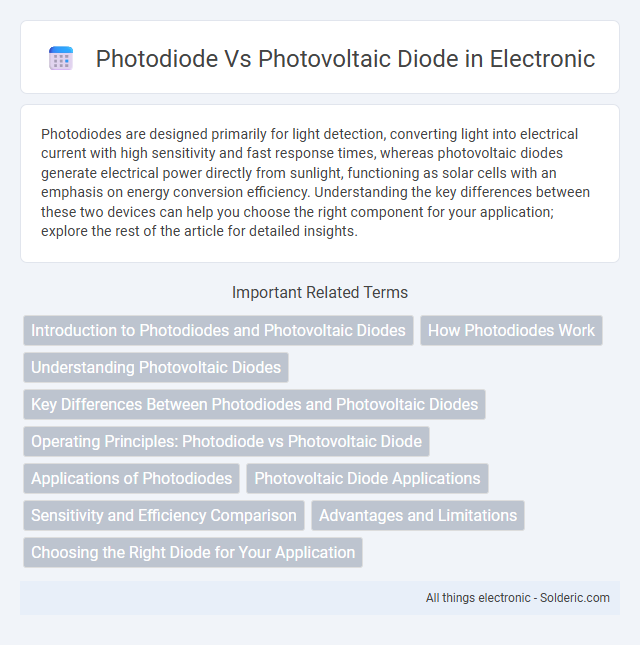Photodiodes are designed primarily for light detection, converting light into electrical current with high sensitivity and fast response times, whereas photovoltaic diodes generate electrical power directly from sunlight, functioning as solar cells with an emphasis on energy conversion efficiency. Understanding the key differences between these two devices can help you choose the right component for your application; explore the rest of the article for detailed insights.
Comparison Table
| Feature | Photodiode | Photovoltaic Diode |
|---|---|---|
| Primary Function | Detects light and converts it into electrical current | Generates voltage and current from light, used in solar cells |
| Operation Mode | Reverse-biased for quick response and sensitivity | Operates without bias, generating power from light |
| Output | Current proportional to light intensity | Voltage and current to power external load |
| Applications | Light sensors, optical communication, photometry | Solar panels, energy harvesting, power generation |
| Response Time | Fast response (nanoseconds to microseconds) | Slower response, optimized for energy conversion |
| Structure | PN junction optimized for photodetection | Large-area PN junction optimized for power conversion |
Introduction to Photodiodes and Photovoltaic Diodes
Photodiodes and photovoltaic diodes are semiconductor devices designed to convert light into electrical signals, with photodiodes primarily used in photodetection applications and photovoltaic diodes functioning as solar cells for energy conversion. Photodiodes operate under reverse bias to generate a photocurrent proportional to incident light intensity, enabling high-speed and sensitive optical detection. Photovoltaic diodes, on the other hand, generate a voltage and electrical power directly from light without external bias, making them essential components in photovoltaic energy systems.
How Photodiodes Work
Photodiodes convert light into electrical current by generating electron-hole pairs when photons are absorbed in the semiconductor material. The built-in electric field at the p-n junction separates these charge carriers, creating a photocurrent proportional to the light intensity. Unlike photovoltaic diodes that generate voltage in solar cells, photodiodes primarily function as photodetectors with fast response times and high sensitivity.
Understanding Photovoltaic Diodes
Photovoltaic diodes are specialized semiconductor devices designed to convert light into electrical energy by exploiting the photovoltaic effect, unlike photodiodes which primarily detect light intensity and convert it to current without significant power generation. These diodes form the core of solar cells, where the p-n junction generates electron-hole pairs under illumination, resulting in a voltage output and electrical power. Understanding photovoltaic diodes involves analyzing their material properties, junction design, and efficiency factors that maximize light absorption and charge carrier collection in renewable energy applications.
Key Differences Between Photodiodes and Photovoltaic Diodes
Photodiodes operate primarily as photodetectors by generating current when exposed to light, functioning efficiently in reverse bias mode with fast response times, while photovoltaic diodes are designed to convert light into electrical energy, commonly used in solar cells operating in zero bias mode. The key differences lie in their application focus--photodiodes excel in sensing and signal detection due to their high sensitivity and speed, whereas photovoltaic diodes prioritize energy conversion efficiency and power generation. Understanding these distinctions helps you select the appropriate device for optical sensing or solar energy harvesting needs.
Operating Principles: Photodiode vs Photovoltaic Diode
A photodiode operates by converting light into current using the photoelectric effect, where photons generate electron-hole pairs in a reverse-biased p-n junction, optimizing sensitivity and response speed. A photovoltaic diode, commonly known as a solar cell, generates voltage and current under illumination without external bias, relying on the photovoltaic effect to create electrical power for energy harvesting. Understanding these operating principles helps you select the appropriate device for applications ranging from light detection to solar energy conversion.
Applications of Photodiodes
Photodiodes are widely used in optical communication systems, light sensing devices, and medical instruments due to their fast response time and high sensitivity to light intensity changes. Unlike photovoltaic diodes, which primarily serve as power generators in solar cells, photodiodes convert light into electrical signals for precise detection and measurement. You can find photodiodes in applications such as barcode scanners, ambient light sensors in smartphones, and safety equipment like smoke detectors.
Photovoltaic Diode Applications
Photovoltaic diodes are primarily used in solar cells to convert light into electrical energy, enabling renewable energy solutions in residential, commercial, and industrial settings. These diodes play a crucial role in photovoltaic panels by generating direct current (DC) from sunlight, supporting sustainable power generation and reducing reliance on fossil fuels. Photovoltaic diode applications extend to power generation in space satellites, portable solar chargers, and integrated solar technologies for smart devices.
Sensitivity and Efficiency Comparison
Photodiodes exhibit higher sensitivity to low light levels due to their rapid response times and specialized semiconductor materials, making them ideal for detecting faint signals. Photovoltaic diodes, designed primarily for solar energy conversion, prioritize efficiency in converting sunlight into electrical power, often achieving conversion efficiencies above 20% in commercial solar cells. While photodiodes excel in sensitivity for precision light measurement, photovoltaic diodes outperform in overall energy conversion efficiency under broad-spectrum sunlight exposure.
Advantages and Limitations
Photodiodes offer fast response times and high sensitivity, making them ideal for detecting light intensity in communication systems, but they require external bias and have limited power generation capabilities. Photovoltaic diodes generate electrical power directly from light without external bias, suited for energy harvesting applications, yet they tend to have slower response times and lower sensitivity compared to photodiodes. Your choice between the two depends on whether you prioritize rapid light detection or efficient light-to-electricity conversion.
Choosing the Right Diode for Your Application
Selecting the right diode depends on the application's energy conversion needs and response time requirements. Photodiodes excel in fast, precise light detection and signal conversion, making them ideal for optical communication and sensor systems. Photovoltaic diodes generate electrical power from light and are preferred for solar energy harvesting and low-power energy sources.
Photodiode vs photovoltaic diode Infographic

 solderic.com
solderic.com